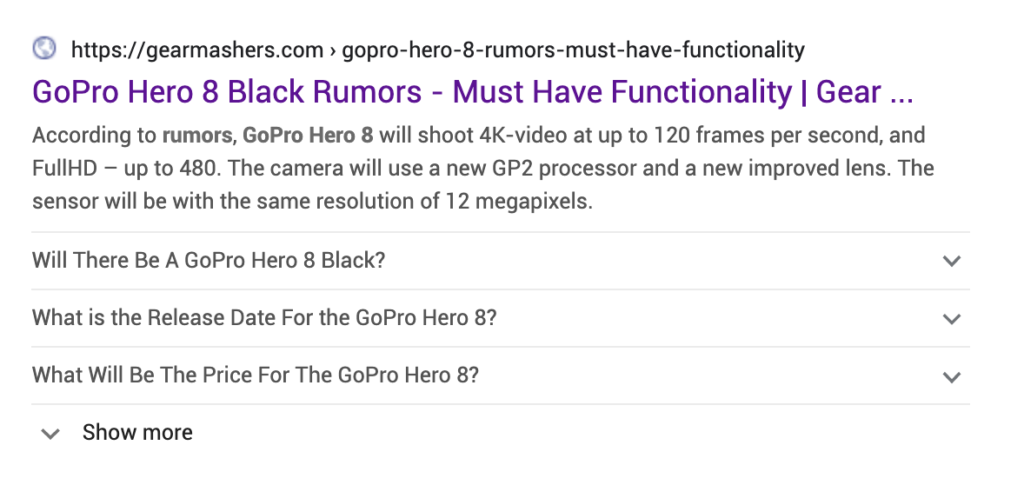So you want to be a rock star and rank in Position 0 of a Google listing in what’s known as a SERP (Search Engine Results Page), then you have come to the right place. Position 0, also known as a Google Featured Snippet is the top organic ranking for a specific search. Essentially Google has devised a method known as a Featured Snippet, where they select what they consider the best result for a question that is searched on.
For example. I wrote an article on Adding Google Analytics To Your Divi Theme and because Google’s algorithm found my article worthy of a Featured Snippet, my article became the top organic listing or Position 0 when someone asks the question “How Do You Add Google Analytics to a Divi theme?”

Did I originally set out to create a Featured Snippet? Actually no, what I really wanted to do was provide a helpful article on how to add Google Analytics to a Divi theme. What I soon learned was Google rewarded my efforts with the top-ranking organic spot. This single article is now responsible for over 20% of my monthly traffic. Imagine if you were able to get 2 or 3 more Featured Snippet articles and all of a sudden your traffic could potentially spike another 40 – 60% or more.
In the example above, not only did I achieve position 0 with a Featured Snippet, but also position 1 within the listings. That is a huge win and something that will certainly drive traffic to the website.
How to Rank in Google’s Featured Snippets
So how does one go about writing an article to become a Featured Snippet? Well, this is the difficult part, there is no single method to achieve position 0. With all the questions people ask every day, the potential answers could be endless. The goal isn’t necessarily to come up with the best answer, but one that is better than the competing answers and do it in a form Google’s algorithm can understand.
There are 4 main formats that I have typically seen that qualify for a Google Featured Snippet.
- Paragraph Snippets: Paragraph snippets are usually in the form of a short one or two sentence answer that addresses the question being asked. The snippets are usually at the top of the article and provide expanded information below which can improve click-thru rates by answering more questions. Obviously Google didn’t exactly answer the question that was being asked in the Paragraph Snippet below, but it does show you what an answer might look like.

- List Snippets: List Snippets are exactly that, lists of items that help answer to the question being asked. When Google includes a list in their Featured Snippet, these tend to take up more room in the SERP and usually have a higher click-thru rate. As you can see the List Snippet’s answer below would take up more room in a Google SERP than the Paragraph Snippet above.

- Table Snippets: Table Snippets are organized in HTML tables using the table tag (<table>) and are also called structured Snippets. Like List Snippets, Table Snippets are there to help answer a question and the information is pulled from a table.

- FAQ Snippets: While not really a Featured Snippet, the FAQ Snippets are created using Google’s Structured Query Language for FAQ. The FAQ snippets normally don’t get you that coveted 0 ranking position, they do push down competitors below your listing.

Do Featured Snippets Have To Contain A Lot Of Text?
In SEO the trend is to write long in-depth content-rich articles vs shorter articles to outrank your competition. There are many reasons for this including increasing time on the page due to reading time, increase the number of long-tail keywords that drive traffic to the article and added value. With Featured Snippets, this isn’t always the case.
A great example is if you were to search for “How Do You Add Google Analytics to Divi”, you will notice my page gets outranked by a page that only answers the question with nothing else. No images, no video, just a short List Snippet that answers the question.

If you were to click on the Answer’s link the following page displays. As you can see the author basically answers the question and doesn’t provide anything else. Google’s Algorithm deemed this article’s answer more worthy than mine and gave it top rankings or Position 0.

The disadvantage of just answering the question often means a user never has to click on your website link to get more information. This isn’t optimal because the goal is to get people on to your website rather than having them display in Google listings. In general, you want to create lists that contain more steps than is viewable in the Google listing, which inevitably will prompt people to click on the link provided.
Let me know if you have reached position 0 with any of your articles and you were able to achieve such a status.









